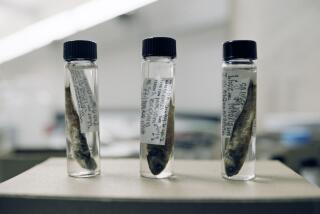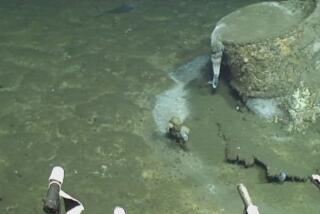Scientists Analyze Trade Center Fallout Culled From City’s Harbor Floor
- Share via
NEW YORK — Sculling between the slips of New York Harbor, scientists have been fishing for the geochemical signature of terrorism, seeking in dank slugs of bottom mud traces left by the caustic plumes of smoke, fiber glass and dust from the collapse of the World Trade Center towers.
The unusual probe is revealing a thin blanket of debris across the harbor floor, like an echo of the ash that smothered Pompeii. It may help public-health experts in years to come gauge the long-term medical consequences of the Sept. 11, 2001, attack.
This unique archive contains traces of chemicals scrubbed from the air and washed from city streets in the days after the Sept. 11 attack, experts at the University of Massachusetts and the National Science Foundation said.
The silt preserves the microfibers of crushed wallboard, insulation and ceiling tiles, as well as traces of metals, such as copper and zinc, from vaporized wiring, fluorescent lights, computers and pipes, an analysis with a scanning electron microscope revealed.
“This is definitely the fingerprint of the World Trade Center,” geochemist Sarah Oktay, who leads the team analyzing the sediments, said Friday at the University of Massachusetts in Boston. “It is quite a coup.”
The team published its preliminary findings in a recent issue of the geophysical journal Eos. Now the researchers have expanded their investigation to see how much of the harbor and rivers that feed it was underneath the ash fall.
Almost 19 months after the attack, the public health puzzle of the World Trade Center plume continues to confound medical and environmental experts.
The force of the collapsing buildings crushed cement, glass and other debris into a powder too fine to be detected by many standard tests. Fires at the trade center site burned for three months, spewing more chemicals and particulates into the wind.
In all, the dust blown into office buildings, apartments and schools has been harder to detect and clean up than expected, researchers said. Medical authorities are particularly concerned about the long-term health effects among the 3,000 children and the 1,500 pregnant women living within a half mile of the trade center at the time of the attack.
Despite testing and studies by researchers from the U.S. Environmental Protection Agency and the U.S. Geological Survey, no one has reliably identified all the toxic chemicals and particles that billowed up from the building ruins, nor are experts certain of the long-term medical effects. The airborne dust contained surprisingly high levels of asbestos, lead and mercury, with many times the legal maximum of a variety of potentially carcinogenic chemicals.
“We just can’t tell at this point what was in the air, how far the material spread and what’s in it chemically, both in terms of contaminants and building materials,” said Don Rice, director of the NSF chemical oceanography program, which funds the harbor studies.
The fallout from the attack is recorded in a layer of harbor sediment about half an inch thick that contains unusually high concentrations of fiberglass, copper, zinc, calcium, strontium and other elements, the researchers found.
More than two-thirds of the ash layer is gypsum, thought to be from the drywall used in the two towers.
The researchers first sampled bottom sediments at two sites along the Lower West Side of Manhattan, between Pier 32 and Pier 40, comparing them with dust and ash samples gathered from streets around the World Trade Center a week after the attack.
Now they are analyzing core samples gathered near Ellis Island and the New Jersey shore, Oktay said, to see how far the fallout was blown. They hope to finish their analysis by the end of the year.






